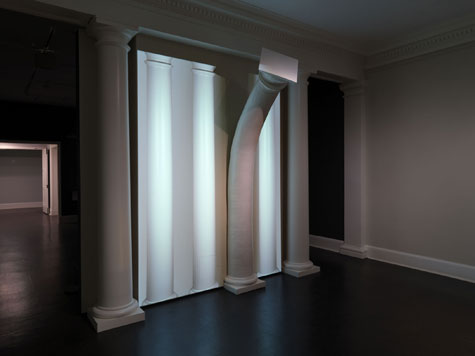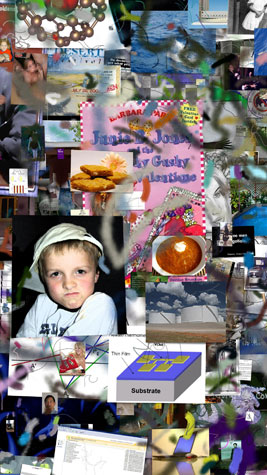
Photo: Erik Gould, Courtesy of Museum Of Art, Rhode Island School Of Design, Providence
SURREAL SURPRISE Johnson and Peterson’s “Column” (2010). |
If you were going to create a portrait of the Internet, what would it look like? I tend to picture something like Keanu Reeves in sunglasses and trench coat breathlessly dashing around The Matrix or Jeff Bridges racing a motorcycle across the neon disco video game land of Tron.
This isn’t just an idle question, but one coming up with increasing frequency in the art world. For artists, the Internet is a mirror of our society, in all its convoluted, glorious messiness. But the Internet has confounded artists. How do you distill something so vast and chaotic and, perhaps, beautiful? The most frequent solution is Brooklyn artist Siebren Versteeg’s answer in his exhibit “In Advance of Another Thing” at the RISD Museum (224 Benefit Street, Providence, through October 10): data processing.
His Triptych (2009) imitates the look of Renaissance altarpieces, with a computer outputting images it finds on the Web to three gold-framed vertical monitors. It shuffles through a poster for Tim Burton’s film Alice in Wonderland, an abstract painting, a subway mosaic of an ice cream cone, a heart surrounded by barbed wire, a gold leaf triptych of an enthroned Jesus, skulls, flowers, Hugo van der Goes’s 15th-century Nativity, a Madonna and child, a dance trio. Most of the images appear once and are gone, but the computer repeats Hans Memling’s 1467 triptych Last Judgment, with Jesus seated in glory on a floating orb and an angel separating out a naked populace into those going to Heaven and those hurled into fiery Hell.

Photo: Erik Gould, Courtesy of Museum Of Art, Rhode Island School Of Design, Providence
CHAOTIC A detail from Versteeg’s “New York Window” (2008). |
Versteeg programs his computers to search the Net for images, with some guidelines, and then display what they find. In this case, it might be Google Images results for combinations of the terms: triptych, apocalypse, art, Jesus, skull, Madonna, baby, Heaven, Hell. Or something like that.
Flag (2008) pastes pictures the computer finds on the Web atop an image of the American flag, layering them, and then “spray painting” them out and sticking more on top. Repeat. It’s a bit like watching a wall randomly postered and graffitied. One viewing might feature pictures of cheerleaders, a bishop, a baby, a cactus, a computer, cookies, women in black and white outfits, a map of the United States, Michelangelo’s Sistine Chapel, a woodpile, a woman with her top pushed up holding her breasts, a snake, an elephant pooping in a giant toilet. It could be a vision of America the religious, the stupid, the sleazy, the banal, the carnival sideshow.
But the primary feeling in Versteeg’s art is randomness. It’s like listening to an iPod shuffle packed with crappy songs and infomercials. It’s an accurate representation of the familiar frustrating feeling of aimless drift of Web searching that can make us feel like we’re wasting our lives. But it doesn’t add up to something; instead, it shatters meaning. It makes me tune out.